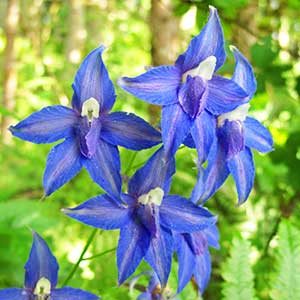Delphinium carolinianum
Delphinium trolliifolium
Carolina larkspur
Columbian larkspur, cow-poison, poison delphinium, poison larkspur
(20-)40-90(-150) cm;
base reddish or not, ± pubescent.
(40-)60-120(-180) cm;
base usually reddish, glabrous to puberulent.
blade round to pentagonal, 1-8 × 2-12 cm, pubescence variable; ultimate lobes 3-29, width 2-10 mm (basal), 1-7 mm (cauline).
blade ± pentagonal, 4-8 × 7-16 cm, margins ± incised, nearly glabrous; ultimate lobes 0-9, width 15-30 mm (basal), 5-20 mm (cauline), widest at middle or in proximal 1/2.
(3-)8-27(-94)-flowered;
pedicel (0.4-)0.7-1.8(-5.7) cm, nearly glabrous to glandular;
bracteoles 1-3.5(-6) mm from flowers, green or blue, linear, 2-7 mm, pubescence nearly glabrous to glandular.
(5-)14-40(-75)-flowered, ± open, at least 2 times longer than wide;
pedicel 1-4(-9) cm, puberulent to glabrous;
bracteoles (2-)6-12 mm from flowers, green, linear, 5-9(-14) mm, puberulent.
sepals purple to blue to white, nearly glabrous, lateral sepals spreading, (7-)9-14(-17) × (3-)3.5-6(-8) mm, spurs ± upcurved, ascending 20-90° above vertical, (9-)11-17(-19) mm;
lower petal blades ± covering stamens, 5-7 mm, cleft 2-4 mm;
hairs centered, densest near base of cleft, white, sometimes blue or yellow.
sepals dark blue, glabrous, lateral sepals spreading, (8-)14-21 × 5-9 mm, spurs straight or downcurved at apex, within 20° of horizontal, (10-)16-23 mm;
lower petal blades covering stamens, 5-10 mm, clefts 1.5-3 mm;
hairs sparse, mostly near junction of blade and claw, centered or on inner lobes, well dispersed, yellow.
(10-)12.5-18.5(-27) mm, 4-4.5 times longer than wide, glabrous to puberulent.
(15-)23-34 mm, 3.8-5.5 times longer than wide, glabrous.
seed coat cells with surfaces pustulate or smooth.
unwinged;
seed coats smooth.
= 16.
Delphinium carolinianum
Delphinium trolliifolium
Subspecies 4 (4 in the flora).
(Discussion copyrighted by Flora of North America; reprinted with permission.)
Delphinium trolliifolium occurs in the northern Coast Range of California, the Columbia River Valley to just east of Mt. Hood, and the Willamette Valley of Oregon upstream to Lane County. California plants differ somewhat from Oregon plants in pubescence patterns and habitat preferences. Further study may show that two entities are involved here.
Hybrids between Delphinium trolliifolium and D. decorum, D. menziesii subsp. pallidum (D. ×pavonaceum Ewan, Peacock larkspur), D. nudicaule, D. nuttallianum, and D. nuttallii are known. Delphinium trolliifolium is likely to be confused only with D. bakeri. Refer to discussion under that species for differences.
(Discussion copyrighted by Flora of North America; reprinted with permission.)
1. Basal leaves absent at anthesis, cauline leaves divided into many narrow (less than 2 mm wide) segments, blade not distinctly 3-parted; distalmost petiole less than 5 mm; sepals usually blue or purple (rarely white). | subsp. carolinianum |
1. Basal leaves usually present at anthesis, and/or cauline leaf lobes usually wider than 2 mm, blade often distinctly 3-parted or more; distalmost petiole more than 5 mm; sepals blue or white. | → 2 |
2. Leaf blade distinctly 3-parted with few additional divisions; sepals blue to white; roots usually ± vertical, often without major branches. | subsp. vimineum |
2. Leaf blade with 3–5 or more major divisions, each further divided into segments; sepals white to very pale blue; roots ±horizontal with several major branches. | → 3 |
3. Stems usually less than 45 cm; in thin soils over limestone in clearings of deciduous woods; leaf blade with 3 major divisions; e of Mississippi River. | subsp. calciphilum |
3. Stems usually more than 45 cm; in deeper soils in grasslands; leaf blade with 5 or more major divisions; w of Mississippi River. | subsp. virescens |
